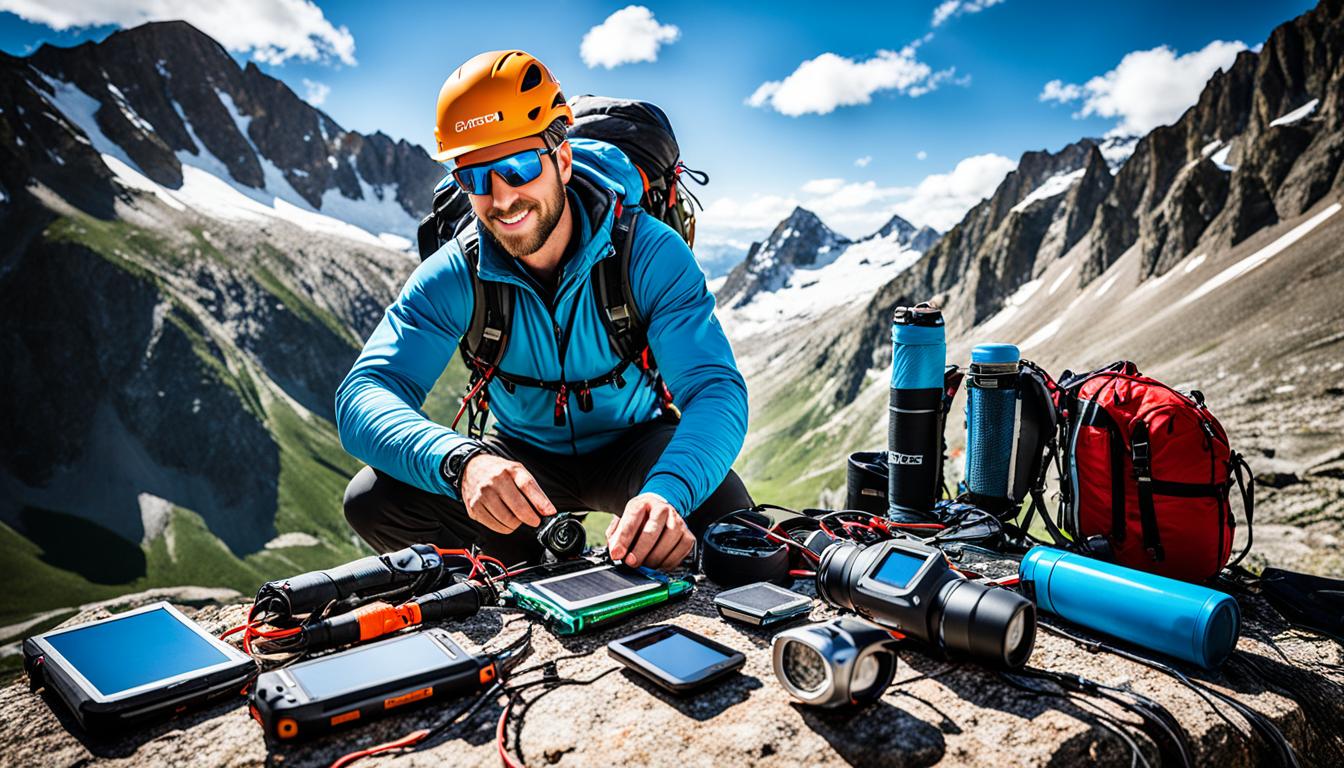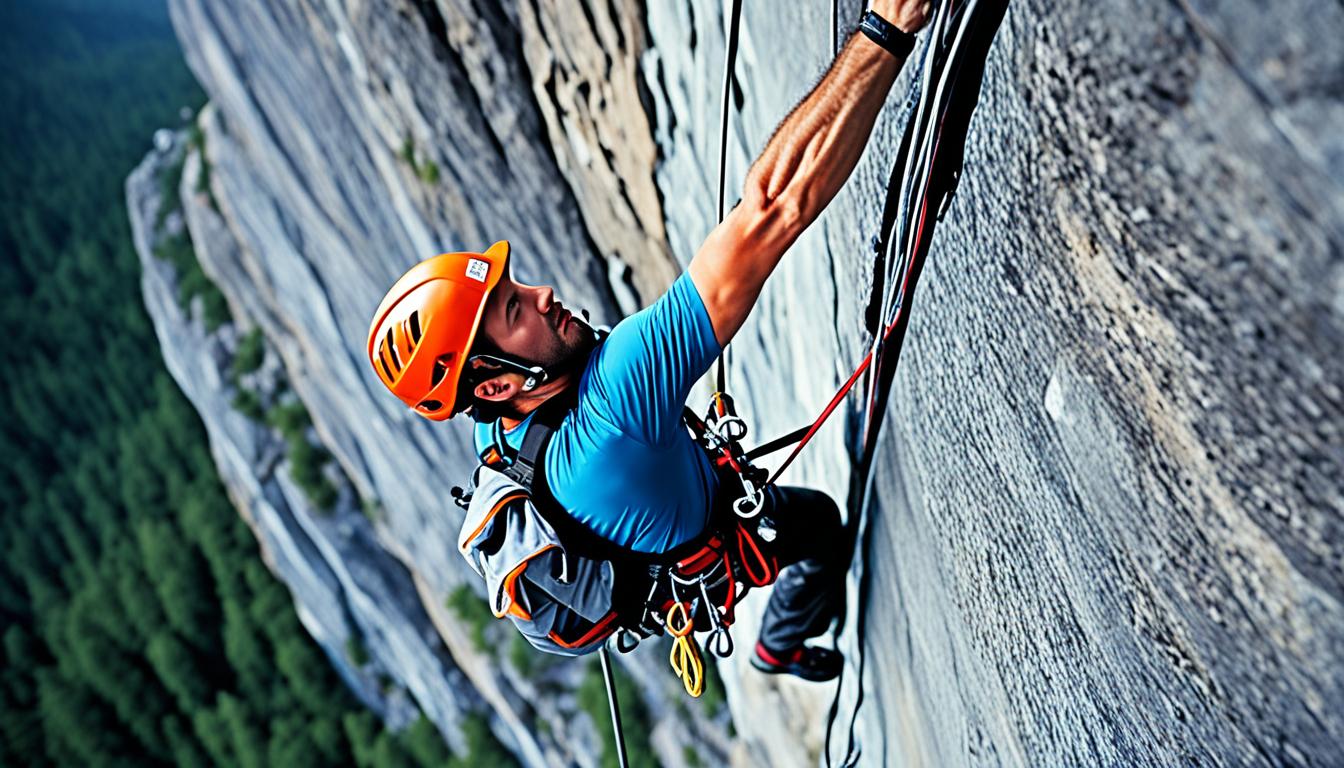A escalada é mais que subir uma montanha. Para os experientes, é uma jornada de superação. Cada movimento é uma conquista e cada estratégia uma chance de se destacar. Dominar técnicas avançadas é essencial para o sucesso em rotas difíceis.
O posicionamento dos pés é crucial na escalada esportiva. Técnicas como back stepping e heel hooks são fundamentais. Elas garantem equilíbrio e economia de energia, permitindo enfrentar rotas difíceis com precisão.
Gerenciar o arrasto da corda é essencial em escaladas desafiadoras. Manter a resistência e reduzir quedas por fadiga é crucial. Dominar as técnicas corretas melhora o desempenho e a segurança.
Os escaladores precisam executar movimentos complexos com precisão. Isso exige flexibilidade, força e coordenação. Quanto mais aperfeiçoados forem esses movimentos, maior será a capacidade de enfrentar desafios.
A escalada também é um desafio mental. Estabelecer metas realistas e dividir a escalada em seções menores aumenta a confiança. O gerenciamento do medo e a leitura de vias são essenciais para superar obstáculos mentais.
Adaptar técnicas de escalada a diferentes estilos é crucial. Escaladas em vias negativas e lajes exigem abordagens específicas. Incorporar técnicas de estilos tradicionais pode fornecer habilidades abrangentes para escaladores em busca de novos desafios.
Principais pontos abordados nesta seção:
- Posicionamento dos pés e técnicas essenciais
- Gestão do arrasto da corda para resistência e segurança
- Execução de movimentos complexos com precisão
- Superando obstáculos mentais através de metas realistas
- Adaptação às diferentes técnicas de escalada
Técnicas Avançadas de Escalada em Topo
Para se destacar em escalada avançada em top-rope, é essencial melhorar técnicas específicas. Isso inclui aperfeiçoar a precisão dos movimentos de movimentação dos pés. Usar técnicas como back stepping, heel hooks, drop knees e flagging é fundamental.
Entender as posições de descanso e gerenciar o arrasto da corda também é crucial. Isso ajuda a garantir resistência e reduzir o risco de quedas. Dominar essas técnicas melhora o desempenho e enriquece a experiência do escalador.
A escalada esportiva em ginásios oferece diferentes modalidades, como boulder, top rope e escalada guiada. A boulder vai de V0 (mais fácil) a V16 (mais difícil), seguindo uma escala global.
As vias de escalada indoor em top rope têm etiquetas plásticas no início com nome e grau de dificuldade. Elas seguem o Sistema Decimal de Yosemite, variando de 5.0 a 5.15c.
As escaladas em artificial usam equipamentos para avançar, em vez de rocha. Isso é popular para subir grandes paredes, como no Yosemite. A escalada livre usa apenas a rocha para apoio, enquanto a escalada solo é feita sem equipamento de proteção.
Para se preparar para a escalada, é importante treinar o core, braços e pernas. Isso ajuda a construir uma base sólida para movimentos eficientes. A força de preensão e resistência também são cruciais, especialmente para os dedos, mãos e antebraços.
Sistemas de Classificação
Na escalada ao ar livre, os guias colocam proteções móveis ao longo da via. Eles removem-as conforme avançam. Na escalada guiada, a classificação de dificuldade segue o Sistema Decimal de Yosemite, amplamente usado na América do Norte.
| Tipo de Escalada | Classificação de Dificuldade |
|---|---|
| Boulder | V0 a V16 |
| Top Rope (Indoor) | 5.0 a 5.15c |
| Escalada Tradicional | Varia conforme a rota |
Na escalada avançada em top-rope, a precisão e a clipagem eficiente da corda são essenciais. É importante dominar as técnicas de movimentação dos pés para escolher os pontos de apoio corretos. A clipagem eficiente aumenta a rapidez e segurança na escalada.
Em vias de escalada longas, o número de esticões varia de acordo com a via e outros fatores. É importante usar equipamentos adequados e conhecer técnicas de segurança. Praticar constantemente ajuda a aprimorar as habilidades necessárias.
Dominando Movimentos Complexos na Escalada
A escalada é um esporte que existe desde o século XVII. Ela mostra como a sociedade pode ser baseada em capital, tecnologia e desempenho. Na escalada, muitos fatores podem afetar o sucesso, como o tempo, a estabilidade da rocha e a habilidade dos escaladores.

Para melhorar em escalada, é importante desenvolver habilidades como precisão, flexibilidade e coordenação. Entender como se posicionar, equilibrar e usar técnicas corretas é fundamental.
Os escaladores precisam melhorar como usam os pés e mãos. Eles também precisam de flexibilidade, força e coordenação para fazer movimentos avançados. Isso inclui ganchos de calcanhar e mantos.
Quando os escaladores dominam esses movimentos, eles podem superar desafios e melhorar sua experiência. A escalada envolve cognição, motricidade, emoções e sociedade. Ela exige inteligências para tomar decisões rápidas e planejar a subida.
Parede Boulder
| Cinco metros de altura do chão. |
| Quase 250 m2 de superfície escalável. |
| Construído em compensado naval de 20mm. |
Área de Fortalecimento
- Objetivos como ampliar os limites do corpo, acabar com sensação de sobrecarga.
Tension Board
- Alternativa recente ao Moon Board.
- Agarras padronizadas em forma e posição.
- Angulação variável de 5 em 5 graus.
Área Yoga
- Yoga indicado para melhoria do nível de energia e saúde do corpo e da mente.
Campus Board
- Inventado por Wolfang Güllich.
- Aparelho para desenvolver força dinâmica nos dedos e braços.
Spray Wall
- Muro de escalada repleto de agarras.
- Grande variedade de tamanhos, formas e pegas diferentes.
- Permite a invenção de movimentos e combinações de agarras.
No Brasil, a maioria do território é planície. Mas há montanhas que formam cadeias. Isso cria ótimos locais para escalada. O clima agradável ajuda a tornar a escalada um esporte popular o ano todo.
A escalada é muito cativante porque sempre há novos desafios. Ela exige precisão, flexibilidade e coordenação. Isso permite que os escaladores superem limites e vivenciem a natureza de forma única.
Superando Desafios Mentais na Escalada
A escalada é um esporte que desafia tanto fisicamente quanto mentalmente. O medo, a ansiedade e o estresse podem afetar o desempenho e a segurança dos escaladores. É crucial desenvolver habilidades mentais e usar estratégias eficazes para superar esses obstáculos.
Visualizar a realização de escaladas bem-sucedidas é uma técnica poderosa. Isso ajuda a construir uma mentalidade positiva, aumentando a confiança e a motivação. Ao imaginar-se alcançando seus objetivos, os escaladores se preparam melhor emocional e mentalmente.
As técnicas de mindfulness também são muito úteis. Elas ajudam a manter o foco no presente e a respiração controlada. Isso reduz o estresse, mantém a calma e aumenta a concentração. Essa prática ajuda os escaladores a lidar com a pressão e a incerteza.
Definir metas claras e alcançáveis é outro ponto importante. Isso fornece direção e motivação. Conquistar pequenas vitórias ao longo do caminho fortalece a confiança e impulsiona o desempenho.
Ter uma mente forte e resiliente é essencial na escalada. Os desafios psicológicos, como o medo e o fracasso, testam a força de vontade. Desenvolver técnicas de preparação mental, como visualização e respiração controlada, é fundamental.
A preparação mental é tão importante quanto a física na escalada. Ela ajuda a desenvolver resiliência, confiança e motivação. Buscar apoio de parceiros ou mentores também é benéfico, oferecendo suporte emocional.
| Desafios Mentais na Escalada | Informações Relevantes |
|---|---|
| Brasileiros desistem mais facilmente de escaladas em montanhas em comparação com estrangeiros. | Estatística de desistência de escaladas por brasileiros |
| Tempo gasto para aclimatação em uma montanha de altitude é consideravelmente maior do que em montanhas mais baixas. | Informação sobre tempo de aclimatação em montanhas de altitude |
| Dificuldade em ter boas noites de sono em altitude, causando dores de cabeça, insônia, alucinações, entre outros sintomas. | Efeito da altitude no sono e possíveis sintomas |
| Fatores como a solidão, incerteza do ambiente e tempo prolongado em altitude contribuem para a angústia dos escaladores. | Influência de fatores psicológicos na experiência de escalada em altitude |
| A “síndrome do retorno imediato” é comum, levando pessoas a desistirem da escalada por impulso de voltar para casa. | Ocorrência da “síndrome do retorno imediato” durante a escalada |
Superar os desafios mentais é crucial para obter resultados satisfatórios na escalada. Desenvolver habilidades de visualização, gerenciar o medo e cultivar a resiliência mental são essenciais. Isso ajuda a enfrentar as dificuldades psicológicas do esporte.
Adaptando-se a Estilos de Escalada Diversificados
A escalada esportiva tem vários estilos, como vias negativas, lajes e paredes verticais. É essencial adaptar-se a esses estilos para ter sucesso. Isso significa aprender técnicas avançadas e ajustar o estilo de escalada para cada tipo de agarra.
Entender as diferenças entre os estilos, como a técnica de pés e a força de agarre, melhora o desempenho. A variedade de estilos ajuda os escaladores a desenvolver habilidades úteis. Isso é importante para quem busca novos desafios.
Os escaladores precisam estar prontos para qualquer tipo de desafio. Adaptar-se a diferentes estilos é fundamental para quem quer superar limites físicos e mentais.
Enfrentar vias negativas, lajes escorregadias ou paredes íngremes requer adaptação. A chave para dominar qualquer estilo é ser adaptável.



Lottery number patterns are fascinating, but creative outlets are vital too! I’ve been exploring music creation tools – Sprunki looks amazing for Spanish speakers, especially with its accessible web interface. A fun way to boost those lucky vibes! ✨
Understanding game probabilities is key to enjoying any dice game! It’s fascinating how small changes impact outcomes. Thinking of leveling up my skills – might check out jili boss casino login for a premium gaming experience and see how the pros approach strategy! 🤔
Responsible gaming is so important! It’s great to see platforms like ttjl link prioritizing a smooth, verified experience-KYC is key for peace of mind. Finding entertainment and feeling secure is a win! 👍
Yo, check out uuu555! Solid selection of games. I was skeptical at first, but I won a few bucks, so I’m happy. Give them a try! Learn more at: uuu555
Alright, World777login, let’s talk. The interface looks a bit dated, not gonna lie. But, the odds are competitive, and I did manage to cash out without any hassle. So, mixed bag. Might be worth it if you’re after specific markets. Check it out for yourself here: world777login.
OkWing Gift Code Today, I’m hunting for a gift code to get a bonus. Where are those at?! I need an edge! Get your code here: okwingiftcodetoday